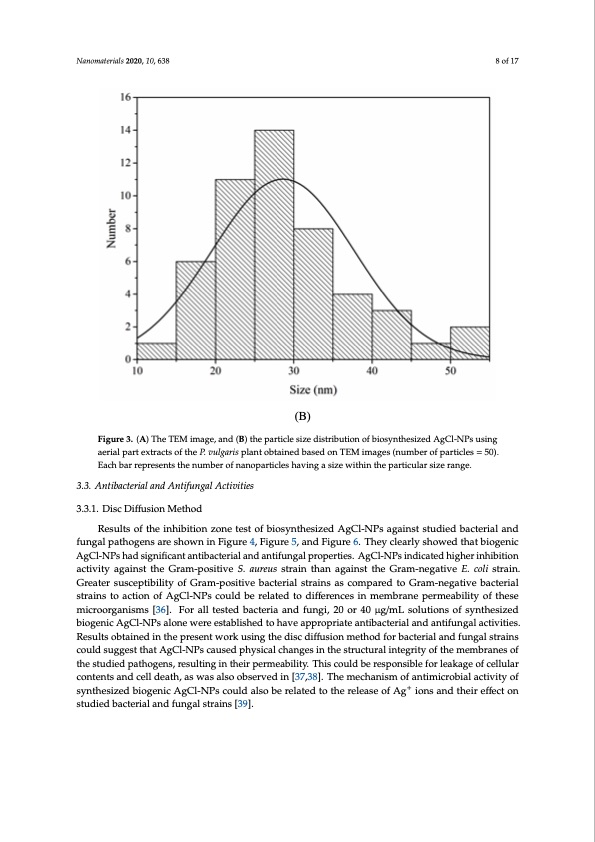
PDF Publication Title:
Text from PDF Page: 008
Nanomaterials 2020, 10, 638 8 of 17 Nanomaterials 2020, 10, x FOR PEER REVIEW 8 of 17 (B) Figure 3. (A) The TEM image, and (B) the particle size distribution of biosynthesized AgCl-NPs using Figure 3. (A) The TEM image, and (B) the particle size distribution of biosynthesized AgCl-NPs aerial part extracts of the P. vulgaris plant obtained based on TEM images (number of particles = 50). using aerial part extracts of the P. vulgaris plant obtained based on TEM images (number of particles Each bar represents the number of nanoparticles having a size within the particular size range. = 50). Each bar represents the number of nanoparticles having a size within the particular size range. 3.3. Antibacterial and Antifungal Activities 3.3. Antibacterial and Antifungal Activities 3.3.1. Disc Diffusion Method 3.3.1. Disc Diffusion Method Results of the inhibition zone test of biosynthesized AgCl-NPs against studied bacterial and Results of the inhibition zone test of biosynthesized AgCl-NPs against studied bacterial and fungal pathogens are shown in Figure 4, Figure 5, and Figure 6. They clearly showed that biogenic fungal pathogens are shown in Figures. 4, 5, and 6. They clearly showed that biogenic AgCl-NPs AgCl-NPs had significant antibacterial and antifungal properties. AgCl-NPs indicated higher inhibition had significant antibacterial and antifungal properties. AgCl-NPs indicated higher inhibition activity against the Gram-positive S. aureus strain than against the Gram-negative E. coli strain. activity against the Gram-positive S. aureus strain than against the Gram-negative E. coli strain. Greater susceptibility of Gram-positive bacterial strains as compared to Gram-negative bacterial Greater susceptibility of Gram-positive bacterial strains as compared to Gram-negative bacterial strains to action of AgCl-NPs could be related to differences in membrane permeability of these strains to action of AgCl-NPs could be related to differences in membrane permeability of these microorganisms [36]. For all tested bacteria and fungi, 20 or 40 μg/mL solutions of synthesized microorganisms [36]. For all tested bacteria and fungi, 20 or 40 μg/mL solutions of synthesized biogenic AgCl-NPs alone were established to have appropriate antibacterial and antifungal activities. biogenic AgCl-NPs alone were established to have appropriate antibacterial and antifungal Results obtained in the present work using the disc diffusion method for bacterial and fungal strains activities. Results obtained in the present work using the disc diffusion method for bacterial and could suggest that AgCl-NPs caused physical changes in the structural integrity of the membranes of fungal strains could suggest that AgCl-NPs caused physical changes in the structural integrity of the studied pathogens, resulting in their permeability. This could be responsible for leakage of cellular the membranes of the studied pathogens, resulting in their permeability. This could be responsible contents and cell death, as was also observed in [37,38]. The mechanism of antimicrobial activity of for leakage of cellular contents and cell death, as was also observed in [+37,38]. The mechanism of synthesized biogenic AgCl-NPs could also be related to the release of Ag ions and their effect on antimicrobial activity of synthesized biogenic AgCl-NPs could also be related to the release of Ag+ studied bacterial and fungal strains [39]. ions and their effect on studied bacterial and fungal strains [39].PDF Image | Synthesis of Biogenic Silver Nanoparticles Aerial Part Extract

PDF Search Title:
Synthesis of Biogenic Silver Nanoparticles Aerial Part ExtractOriginal File Name Searched:
nanomaterials-10-00638.pdfDIY PDF Search: Google It | Yahoo | Bing
Turbine and System Plans CAD CAM: Special for this month, any plans are $10,000 for complete Cad/Cam blueprints. License is for one build. Try before you buy a production license. More Info
Waste Heat Power Technology: Organic Rankine Cycle uses waste heat to make electricity, shaft horsepower and cooling. More Info
All Turbine and System Products: Infinity Turbine ORD systems, turbine generator sets, build plans and more to use your waste heat from 30C to 100C. More Info
CO2 Phase Change Demonstrator: CO2 goes supercritical at 30 C. This is a experimental platform which you can use to demonstrate phase change with low heat. Includes integration area for small CO2 turbine, static generator, and more. This can also be used for a GTL Gas to Liquids experimental platform. More Info
Introducing the Infinity Turbine Products Infinity Turbine develops and builds systems for making power from waste heat. It also is working on innovative strategies for storing, making, and deploying energy. More Info
Need Strategy? Use our Consulting and analyst services Infinity Turbine LLC is pleased to announce its consulting and analyst services. We have worked in the renewable energy industry as a researcher, developing sales and markets, along with may inventions and innovations. More Info
Made in USA with Global Energy Millennial Web Engine These pages were made with the Global Energy Web PDF Engine using Filemaker (Claris) software.
Infinity Turbine Developing Spinning Disc Reactor SDR or Spinning Disc Reactors reduce processing time for liquid production of Silver Nanoparticles.
| CONTACT TEL: 608-238-6001 Email: greg@infinityturbine.com | RSS | AMP |